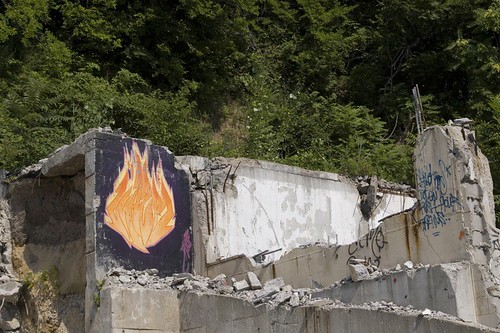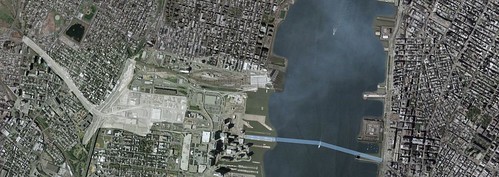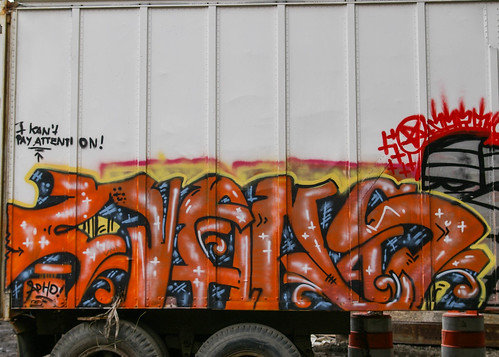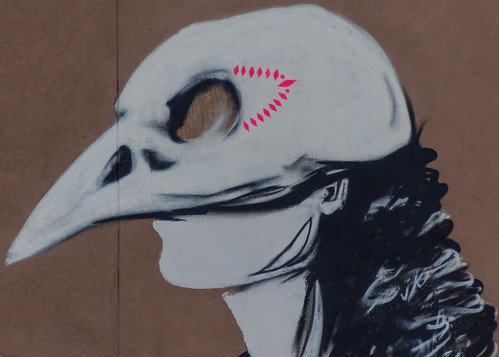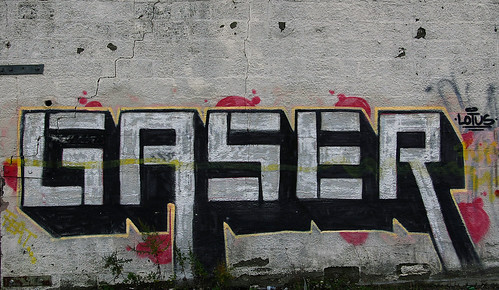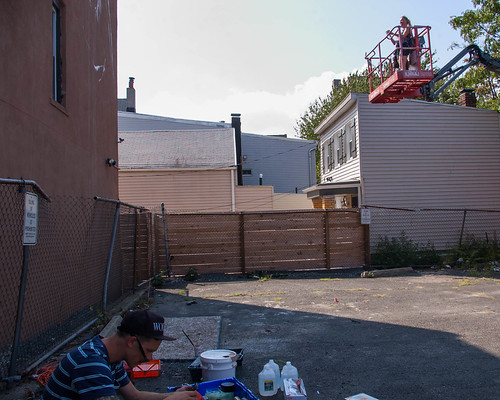This is the third part of a three-part article. Part 1 is here while Part 2 is here. I originally published it on Sept. 25, 2007 at The Valve. A lot has changed since then.
The Photographs
However inadequate photographs may be as documents for presenting graffs, they’re the documents I’ve got. All photographs are tricky beasts. Thus its no surprise that these photos of graffs present the standard challenges of medium and intention.
The most basic problem I’ve had with these photographs is “fixing” the colors when rendering them with the computer – I use Photoshop. The obvious choice, of course, is to get the colors to look like they were when you were actually there. But that appearance is only a memory. The lighting conditions on the screen and in the room where you work or view the images are quite different from those on-site. I have attempted to keep these images more or less within range of what you could actually see at the site.
These images also present a specific temptation. When newly painted the colors of graffs tend to be bright and their surfaces smooth and shiny. But they age quickly; the surface becomes dull and the colors faded. It is quite easy to brighten the images of aged graffs in Photoshop, perhaps even to something like they appeared when new. But how can you tell? No doubt I have succumbed to that temptation here and there, but not too egregiously.
There is another issue, that of intention. These photographs document the work of other artists. Ideally I should take a “neutral” or “transparent” stance in composing and framing my shots so that one sees only what the artist intended, with minimal interpretive interference from the photographer, i.e. me. I have taken and prepared many photographs in this vein.
But not all of them, not by any means. These are not easel paintings, created as self-contained aesthetic objects. These pieces exist out in the world where what happens to them is beyond the control of the artists or of museum curators. Some of them may be conceived in the spirit of easel paintings, first developed in sketches and then executed on whatever surface is available. But some of them – I have no idea of the percentage – will have been improvised on the spot, where the artist is susceptible to the immediate context. However they were conceived, whatever the artist’s intentions, graffs exist outdoors in contexts where their appearance changes according to time of day, season of the year, and current weather conditions. Their surfaces will degrade, as I’ve already mentioned, and others will come along and write over the topmost layer of imagery.
These things are important, and I have attempted to document them. I have taken many photographs where I am interested in documenting the context in which these graffs exist. The more image area I devote to surrounding context, the more choice I must exercise in choosing that context and framing the graffs within it. As I do this I am inevitably imposing circumstances on the graffs that are arbitrary with respect to whatever intention the writer may have had. In choosing those circumstances I am interpreting those graffs; I am taking what the world presents to me and using my craftsmanship to create order and meaning.
For example, when I photographed that
rock-form AIDS graff (Figure 2) through the trees, I was interpreting the graff. To be sure, I did not create the trees, or the lighting, much less manipulate the graff itself. But I choose that particular shot, at that time of day, because I wanted to create a certain kind of image. I wanted to create the image of a mysterious structure hidden away in a lost world. Why did I want to create that image?
Because it casts the viewer in the role of an archaeologist investigating a strange but possibly quite wonderful civilization. That’s a useful perspective to take with you into the graff world. It reminds you that you are a stranger here, but it also prompts you to attend carefully to what you see, for it may be your best evidence about the lives of the people who made the images.
In this case, that last is not true. The writers are alive, most of them, though not necessarily available. Still, I believe that we should attend to their work as though it were all we will ever know about them. For I believe that their art will, in time, become ancestral to new schools and styles that we cannot now imagine.
* * * * *
I keep my
online photographs at Flickr, where my screen name is STC4blues. Flickr allows you to organize images into sets, and sets into collections. I’ve organized these images in three collections. The sets in the Sites collection are organized according to location, with one set for each different site. Each set in the Changes collection shows a single surface photographed at different times, with different graffs on it at thos times. The last collection, Categories, organizes set according to some analytic category. The graffs in these sets will not necessarily be at the same site, though in some cases they are.
The Sites
This satellite image from Google Earth shows the area I have been investigating:
That’s the Hudson River in the middle, with the route of the Holland Tunnel drawn on the river. You can see Washington Square Park in Greenwich Village new the right edge below the center. My graffiti sites are within the shaded area to the left. Note that these are not the only graffiti sites in Jersey City; there are others, but they aren't within easy walking distance of where I live and so I haven't investigated them.
Here is a closer look at that area:
Notice the diagonal green area in the middle-right of the image; that’s the edge of the Jersey Palisades. The land to the west (left) of that is roughly 80 to 100 feet above the lad to the east. I will say a bit about each area when I introduce the photos. All I want to do now is to associate names with areas on the map. The names are mind, but some of them are grounded in local usage. Starting from the west:
\BA – EC: Bergen Arches – Erie Cut
BR: Brunswick Tracks
CT: The Cut, but not the Erie Cut, though physically close to it.
YD: The Yard
SK8: Skate Park
S: Chocolate Factory, South
N: Chocolate Factory, North
JC: Jersey-Coles
HC: Holland Corridor
Pushpins:
Blue: Dickinson High School (up on the Heights overlooking downtown)
Green: Apartment building where I live
Red: Toll booths for Holland Tunnel
I currently have 21
sets organized by site (14 when I originally prepared this document). I'’ve listed only some of them below, along with some comments about each and a photograph or two.




